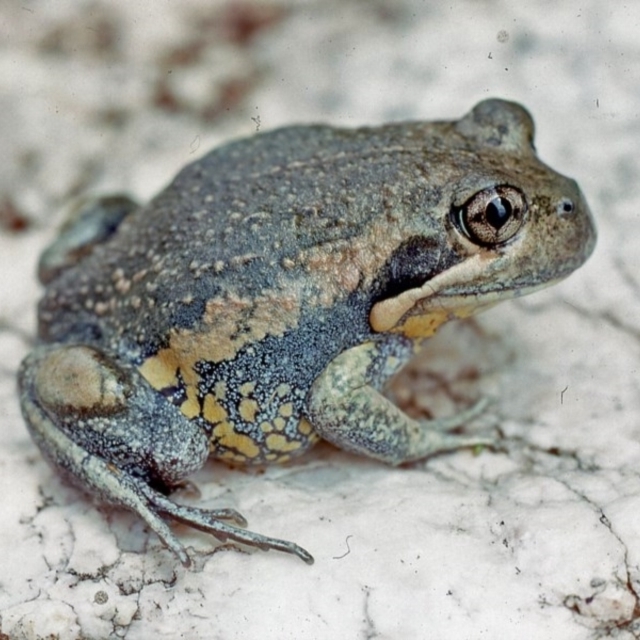Limnodynastes dumerilii (Eastern Banjo Frog)
<p>Eastern Banjo Frog, also known as Pobblebonk or Four-bob Frog, is a common and widespread burrowing frog may often be found in large numbers at night, particularly after rain. Adult length: 50-85mm.</p>
<p>Current conservation status: Common, possibly declining.</p>
<p>Distribution: Mostly found in northern ACT; widespread below 1200 m.</p>,<p>Eastern Banjo Frog, also known as Pobblebonk or Four-bob Frog, is a common and widespread burrowing frog.</p>
<p><strong>Current conservation status:</strong> Common, possibly declining.</p>
<p><strong>Family:</strong> Myobatrachidae</p>
<p><strong>Appearance: </strong>They are grey-brown in colour and have a white granular stripe from below the eye to above the base of their front leg and a broad, dark band from the eye to the "ear". The legs are thick-set. There is a large raised lump on the outside of each thigh and on the underside of each foot for digging.</p>
<p><strong>Length: </strong>up to 85mm</p>
<p><strong>Breeding:</strong> Breeds from September to early Januar, particularly after heavy rain.</p>
<p><strong>Habitat:</strong> This species is rarely seen because for much of the time they remain hidden in short burrows in the ground. However, on wet summer evenings they may be observed sitting on the road surface. They are often discovered in soil deliveries to urban gardens as they have a habit of burrowing into soft soil.</p>
<p><strong>Distribution: </strong>Widly distributed and common throughout lowland areas in the region and south-eastern Australia. In the ACT mostly found in the northern parts<strong>.</strong></p>
<p><strong>Biology:</strong> Females lay up to 4,000 eggs in a conspicuous, floating, foamy mass with a diameter of about 12-18cm. The tadpoles are large and easy to identify because of their light brown colouration and the presence of numerous pale blotches on the tail. In high altitude, tadpoles can take up to two summers to reach metamorphis.</p>
<p><strong>Call</strong>: Their call sounds like a deep, slow repeated "thud"or "bonk" when calling from the water, or a loud "toc" if calling from land.</p>
Limnodynastes dumerilii is listed in the following regions:
Canberra & Southern Tablelands | Southern Highlands | Albury, Wodonga | South Coast | Central West NSW | Riverina Murray | New South Wales North Coast | Hume | Barwon South West | Loddon Mallee
Species information
- Limnodynastes dumerilii Scientific name
- Eastern Banjo Frog Common name
- Not Sensitive
- Local native
- Non-invasive or negligible
- Up to 1550.52m Recorded at altitude
- 155 images trained Machine learning

























